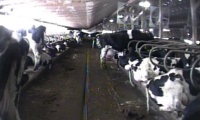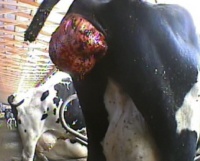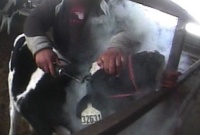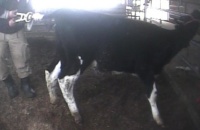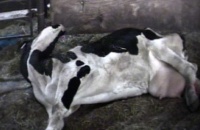 |
|
|
|
|
|
|
|
|
|
|
|
|
|
|
|
|
 |
|
Day 1 The mechanic training me says of the cows, "You'll learn to hate them." He screams profanities at them and occasionally whips them with a frayed steel cable. He charges at others with a large wrench. Day 3 Cows are densely stocked in long lanes on manure-covered floors. They are restricted to either standing in the manure or lying in “free stalls,” which consist of long, thinly padded slabs of concrete within the lanes, elevated and separated into compartments by steel bars. These compartments serve as beds and are termed “free” because cows are not chained to the bars by their necks; however, the stalls are too short and narrow for the cows to freely move or lie down comfortably and result in open sores where their bodies hang over the concrete edges. Cows never leave their lanes, except when herded to and from the milking parlor. They will not see the outdoors until they are loaded onto a truck and sent for slaughter. Day 5 I saw a milking parlor for the first time. Eight workers milk approximately 500 cows an hour. The environment is filthy, with manure covering not only the floors, but the legs and often undersides of the cows. Day 8 I noticed several pools of blood in one lane. I pointed this out to a worker, who said, "They're f---ing cutting their leg on the [manure] scrapers" and then went back to his work. Day 11 I saw seven cows leaking milk, two with damaged eyes (which a mechanic explained was from a "hard birth") and at least a dozen with severely swollen hocks. In the sick pen, I found two dead calves heaped in the corner. I also observed a cow with a severely prolapsed uterus, which I pointed out to a worker, who smiled and walked off. I asked him what would happen to this cow. "She won't be having another cycle, so she'll probably be hamburger soon. The only way a cow won't become hamburger is if she dies in the lanes or is too sick to walk to auction. Then she's dog food." In the dead pile, I found a recently dead cow. A trail of blood led from the corpse to one of the barns, where I found a worker welding a gate. He explained that the cow had become caught in the manure scraper and dragged into the gate, crushing her to death before the gate broke. Day 12 I noticed approximately 22 cows with swollen hocks. Some were swollen larger than baseballs and several had open sores. Many sores were impacted with manure, infected and discharging pus. One cow appeared to be non-ambulatory. She was emaciated, with sores and bald patches along her protruding spine. None of these animals appeared to have received any medical treatment. Many cows appeared to have painful udder infections. Their teats were inflamed or discolored, an indication of severe mastitis. Day 13 Workers struggled to contain a manure overflow that had covered the milking parlor in excrement all week. Day 16 I began the day repairing one of the "crowd gates" – electrified metal gates, which close in on the herds, producing electric jolts to force them into the milking parlor. The cows appear afraid of the gate and run from it. When the herds become too crowded, some cows become pressed against the gates to suffer repeated shocks. I also observed workers feeding the calves. They held the calves' necks between their legs, yanked their heads up and dumped formula down their throats. An uncooperative calf was frustrating one worker, so he kicked her so hard that she flew back several feet against the wall of her stall. Day 17 I discovered a cow lying near death, her leg caught between a gate and a water vat with the bone exposed. Day 18 I observed workers administering Bovine Growth Hormone (BGH) shots to several hundred cows. Cows continue to be milked for human consumption while on the drug. Over 35 different drugs are commonly injected into cows at this operation. The water provided to the cows is opaque brown, with chunks of feed, manure, and other debris floating on top and caked to the sides. I asked the mechanic if anyone ever cleaned them. He replied, “No, they're too f---ing lazy. All they gotta do is pull the drain and fill them back up again. They don't ever wash ‘em, not even in the summer.” Day 19 Workers slapped and prodded lame cows to herd them into the milking parlor. A worker explained to me that unless a cow has been recently injected with penicillin, all milk goes to market, even that of sick and lame cows. One cow was badly limping. On her way into the parlor, she collapsed. Three workers tried to get her to stand by slapping and jabbing her with keys and sticks for several minutes until she lumbered to her feet and limped into the parlor where she was milked for human consumption. Day 20 Newborn calves are kept in a barren, frigid tin shed. I found a calf that had frozen to death, lying near two other calves that seemed close to death themselves. I told a worker about the dead calf. He examined her and agreed that she had died of cold during the night, but insisted that the others were fine. Not far from there, I found two other dead calves buried in straw. Taped to a refrigerator was a Cornell University Animal Health Diagnostic Center report, dated November 10, 2008 and titled, “Milk Modified Bacteria Count & Bedding Report.” Results of tests performed on Willet's mature cows found 1,600 cows afflicted with Streptoccus, Staphylococcus and E. coli. Day 22 I witnessed my coworker kick and hit several young heifers with a wrench. Day 24 Workers herded heifers into a transport trailer by kicking, slapping and hitting them with a rod, but the heifers were packed so tightly that the last few couldn't fit. The workers continued to hit the heifers and made several attempts to close the door on them until they were able to force their way in. In the calf barn, I saw dozens of calves with fresh, bloody wounds where their horns had been burned off. My supervisor told me that this was his favorite job. "(We) burn 'em… It's this little iron... and you put it on the little nubs on their head and it kills it off. It's like, 'sssssss.' I used to love doing that." "The cows don't like it?" I asked. "Would you?" he replied. "Oh f---, it's gotta be f---ing very painful... Oh yeah, I used to love that sh-t... blood and smoke all over the place. YEAH! Hamburger." Day 25 As usual, my supervisor treated the clogged manure pump in the milking parlor by reversing it to spray onto the cows in the milk line. Outside of the sick pen, I found three dead calves frozen in the snow. One of their heads was split open. I noticed the posted results of a test performed on milk samples from "fresh cows" that had just given birth. All tested positive for staph species, most for corynebacteria species and one for gram-positive bacillus. Day 27 I observed three downed cows that had been languishing for several days. One had a large, infected gash on her leg. I called over a worker. "¿Está enferma?" (Is she sick?) I asked. "Yeah," he said. "Almost dying." I suggested euthanizing her. He replied, "Yeah… she'll just die." I saw the cow with the prolapsed uterus again. She had still not been treated. Day 28 I witnessed the disbudding and tail-docking process. A worker restrains the calves and ties their mouths shut with rope, then burns off the newly budding horns with a hot iron. The calves struggle but, bound and gagged, there is not much that they can do. The worker sticks his fingers in their eyes as he restrains them. They make gurgling noises, kick, and several fall over. Some calves choke up what appeared to be vomit from the pain. The worker then docks the tails using a tool that is mainly used to castrate bulls. He attaches it to the calves' tails and turns it until the ends of the tails tear off, after which he cauterizes the exposed vertebrae. The animals receive no anesthesia, and are clearly in extreme pain. Day 29 I discovered a calf that appeared severely ill. I asked the worker responsible for newborns about her, and he told me that she was cold and would soon be dead. This was at 8:30 a.m. At 4:30 p.m. the dying calf was still in the same place, her throat barely expanding and contracting in slow breaths. Her eyes were completely gray. I sat down beside her and stroked her hair. She did not respond, but when I got up to walk away, she let out a weak bleat, so I returned and continued to pet her. Day 30 I asked a manager what we did with downed cows. He said, "We give 'em a couple weeks and if they don't get up we f---ing shoot 'em." "They ain't burger meat?" I asked. "Some do, some don't," he answered. "All depends [on] which ones [are] loaded up with antibiotics." A truck driver loaded five cows from the sick pen to be sold as meat. I found the calf I had seen yesterday – the one left to freeze to death. She was dead and had been dragged into a corner. Two other calves cuddled next to each other, shivering from the cold. A mother hovered over the pen, helplessly watching and moaning in distress. My supervisor told me that our cows are impregnated every time their daily production drops below 65 pounds per day, which is four times that which a nursing cow naturally produces. I asked him when they are sent for slaughter. "When they can't f---ing walk," he told me. "So we'll just keep impregnating them until they get sick?" I asked. "Until they're too old or 'til they get sick or something happens to 'em," he said. He told me that they are usually spent by the age of four or five, about a quarter of the natural lifespan of a cow. Day 31 During one particularly slow day, my supervisor entertained himself by punching cows in the head. Additionally, he told me stories about prior instances in which he had battered the animals. Last year, he broke his hand by punching a cow in the eye. Another time, he ripped his hand open when he punched a cow in the nose and caught her tooth. He claims that he once clubbed a bull with a 2x4 "like Babe Ruth," and then repeatedly kicked him in the testicles while he was down. He also said that he locked a cow's head in a gate and cracked her over the head with a wrench, dropping her to the floor. He thinks he got arthritis from punching cows. Day 32 I was surprised to hear this same supervisor acknowledge the cows' capacity for emotion. While I repaired a motor, the cows crowded around me and fervently licked my back. He explained that after they calve, their mothering instinct never leaves. I asked him if he had ever seen cows get angry when their babies are taken after calving. He answered with an emphatic "yes," telling me that they think, "If you're taking my kid, you're dead... and then once you f---ing get the calf outta there she'll be runnin' around the box stalls lookin' for it for days." Day 33 I found the staff veterinarian and took him to some of the worst-off downed cows. He told me that he didn't know whether the owners wanted to sell them or shoot them, so he couldn't euthanize them. He said, “I've worked with dairy cows for two years, but sometimes it's bad, you feel bad. A lot of dead cows or sick cows.” He pointed out several cows with abscessed wounds, and commented on the hock wounds that nearly every cow had. “That's a bad thing,” he told me, “because the infection gets into their joints and bones.” Day 36 I asked the cattle hauler whether he ever hauls downed cows. He said that they are typically shot and sold to the rendering company, which turns them into dog food and soap, but that sometimes the line is blurry. “I had one this morning that was close. It got down but we finally got her up.” To be sold for human consumption, the rule is simply that they must walk onto the trailer. Day 37 I overheard a manager explaining that one of the pipes that takes slurry (waste) to a manure lagoon had frozen, and that it was being illegally drained into the local waterway. “So, if you see the DEC (Department of Environmental Conservation) coming, you call and let me know!” Day 38 A cow who has been down for nearly two weeks has begun working her jaw, making an audible grinding sound. Day 39 A calf was born in a lane. The newborn lay on the filthy floor as several cows crowded around and licked her. Had I not happened to be there, the calf would have been scooped up by the manure scraper and deposited into the manure pit, while the cows helplessly looked on. Several workers at this operation have confirmed that this happens on occasion. My supervisor said, “Oh, I've seen (the scrapers) totally obliterate a calf – just cut it in half.” Day 40 At a maintenance staff meeting, the farm's chief director told us that mastitis rates are very high, particularly due to manure getting into the feed. A mechanic told us that some workers use the same skid steer to give feed as they do to scrape out manure. Day 41 One of the downed cows has been lying on the floor for at least 13 days. One of her legs is very swollen. She is still visibly in extreme pain. Another cow has died since I documented her two days ago. There are no bullet wounds or other indicators of euthanasia. I watched a worker pull in a skid steer, scoop her up, and drop her off near the compost heap. The rendering guy came by today and picked up the dead cows. Video | Photo Gallery | Expert Statements | Investigator's Diary | Updates | Take Action |
< |

